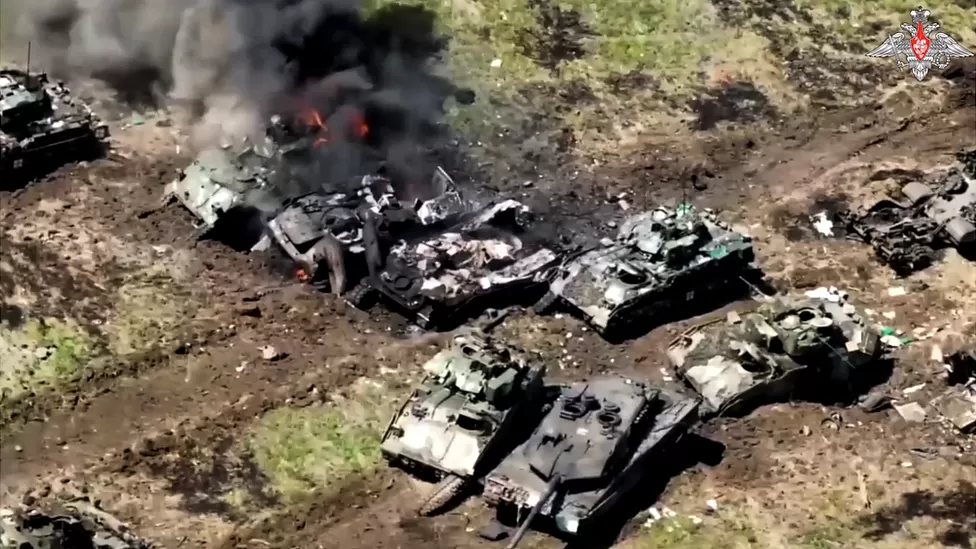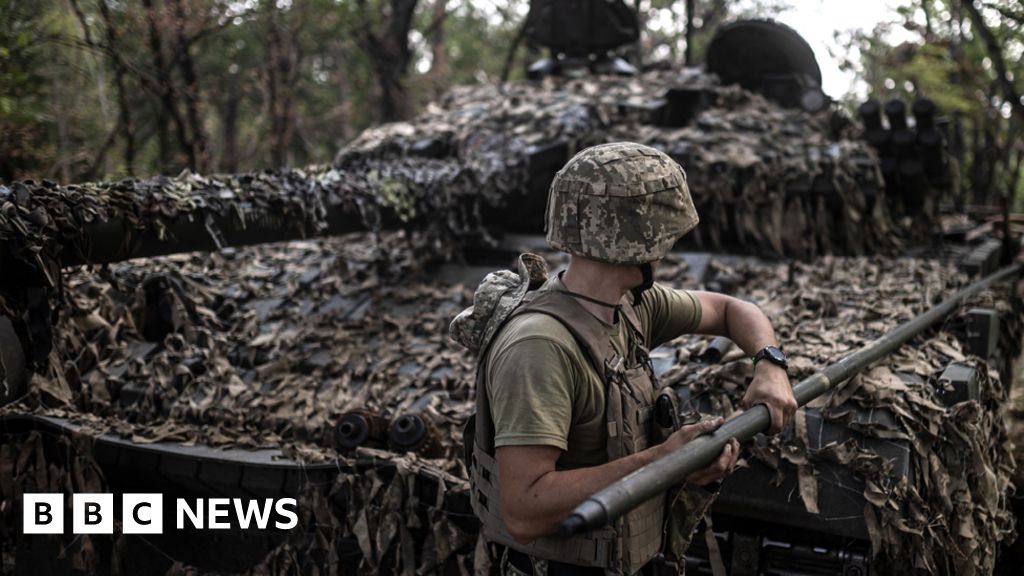The general in charge of Ukraine’s stuttering counter-offensive in the south has said Russian defences are making it difficult for military equipment, including Western tanks and armoured vehicles, to move forward.
Gen Oleksandr Tarnavskyi says his forces are struggling to overcome multi-layered minefields and fortified defensive lines.
“That is why most of the tasks have to be performed by troops.”
He says Russia’s military has displayed “professional qualities” by preventing Ukrainian forces from “advancing quickly”.
“I don’t underestimate the enemy,” he adds.
Latest unconfirmed reports from the US suggest the main thrust of the counter-offensive has begun. The Institute for the Study of War says Ukrainian forces appear to have broken through “certain pre-prepared Russian defensive positions”.
But so far there’s little evidence that Western supplied tanks and armoured vehicles have been able to tip the balance decisively in Ukraine’s favour.
Several Leopard tanks and US Bradley fighting vehicles were damaged or destroyed in the first days of the offensive, near the city of Orikhiv.
Ukraine’s 47th Brigade, which had largely been trained and equipped by the West to try to break through Russian lines, were soon stopped in their tracks by mines and then targeted by artillery.
Russia released multiple videos of the incident claiming Ukraine’s offensive had already failed. In reality it was an early setback rather than a decisive blow.

We visited the same brigade’s outdoor workshop, hidden in a forest behind the front line, where they are now trying to repair more than a dozen armoured vehicles - most of them US Bradleys.
They first arrived unscathed but now bear the scars of battle. Broken tracks and buckled wheels - the tell-tale signs that several have hit Russian mines.
Serhii, one of the engineers, says: “The faster we can repair them, the faster we can get them back to the front line to save someone’s life.”
But he also admits that some are beyond repair and will have to be either scavenged for spare parts or “returned to our partners” to be rebuilt.
While Western armour has provided Ukrainian troops with better protection, it has not been able to punch through the rows of Russian mines - one of the biggest barriers for Ukraine’s advance.
Travelling the southern front we also saw British supplied Mastiff armoured vehicles damaged and destroyed.
The 47th Brigade is now using some of its older, Soviet-era tanks to clear minefields. But they too can’t escape the explosives hidden in the ground, even when fitted with specialist mine-clearing equipment.
Nearer the front line, tank commander Maksym showed us his recently-damaged T-64 tank. It’s been fitted with two rollers on the front to deliberately set off the mines. He lost one of the rollers the night before as he was trying to clear a path for troops.
“Normally our rollers can withstand up to four explosions,” he says. But the Russians, he adds, have been laying mines on top of each other to destroy their mine clearing equipment.
“It’s very hard because there are too many mines,” Maksym says, adding that there were often more than four rows of minefields in front of the Russian defensive lines.
It’s been painful to watch the battle unfold for Doc and his drone reconnaissance team from Ukraine’s Volunteer Army.
Doc, his call sign, took part in last year’s successful offensive on Kherson. But he says this time it’s proving to be much tougher. For the first time in the war, he says, soldiers are being injured by mines more than artillery: “When we go forward we meet minefields everywhere.”
Doc shows me a video he recently filmed from one of his drones while Ukrainian troops advanced towards a Russian trench.
There’s a massive explosion as soon as the soldiers enter. The trench was empty but rigged with mines. Doc says Russian forces are now using remotely controlled mines. “When our soldiers get to the trenches they push a button and it blows up, killing our friends.” He says he’s seen the tactic being used over the past two weeks and calls it “a new weapon”.
There is a military logic to Ukraine’s offensive in the south. It’s seen as key to dividing Russian forces and reaching the occupied cities of Melitopol and Mariupol - all the way to Crimea. But the focus on this axis means that Ukraine is also now attacking Russian defensive lines where they’re strongest.
Gen Tarnavskiy said his forces were doing “hard and painstaking work”. He said “any defence can be broken but you need patience time and skilful actions”.
Ukraine was slowly wearing down their enemy, he said. Russia didn’t care about losing men, and recent changes in their military leadership “means everything is not OK”, he added. He insisted that Ukraine had yet to commit its main strike force.
“Slow or not, the offensive is taking place and it will definitely reach its goal,” he says.
I ask Gen Tarnavsky how we can judge whether it’s a success or a failure?
He smiles and replies: “If the offensive were not successful, I wouldn’t be talking to you now.”




I am skeptical about that. We would have heard about it already if it was that effective. The problem is that the mines are as ground level as it can be, while the cluster munitions will be deadly more like a meter above ground or against people. I doubt shrapnel will detonate mines.
Wouldn’t it be possible for the shockwaves of an explosion to detonate a mine?
I don’t know enough of how a mine work to answer this question. But I would imagine the explosive is stable enough that shock usually won’t trigger it, or very unreliably.
It will depends on the mine obviously, but Ukraine is using mines dropped from shells fired from artillery, so I expect at least some kind of mines to be very resistant to shocks, and thus probably also shock waves.